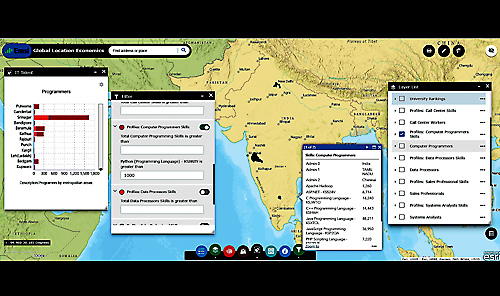{{RELATEDLINKS}} Whereas GDP tracks and measures markets based on manufacturing activities revolving around the import/export and consumption of products, it is critical to recognize that technology innovation is driving and creating new economies through the digitization, distribution, and consumption of explosive volumes of data. Understanding the interrelationships and interdependencies of new service-based economies requires geographically- driven analysis of human capital based on the availability, cost, and sustainability of labor, especially technology talent and skill clusters.
Not a New Concept
People analytics or human resources analytics, a phrase first coined by Google in 2007, has evolved from a buzzword to recognizing the need for analysis of human capital flows across markets and regions to measure how, why, and where talent and skill clusters create and support sustainable market strength. In fact, these types of analytics and the results have rapidly become critical to understand the future economic performance of most markets.
People analytics is not a new concept. Gary Becker, the pioneer of human capital and Nobel Laureate for Economics in 1992, referred to human capital as the abilities and qualities of people that make them productive through levels of academic achievements or trade skills. Today, understanding and analyzing human capital is dynamic and career paths are often not as linear as in previous decades. The demand for more labor data and analytics has grown — from statistical data at a market level that reflects hiring trends to tracking job postings and social profiles and much more.
Area Development’s 32nd annual Corporate Survey and 14th annual Consultants Survey, released in 2018, showed that CEOs from consulting companies are concerned that the availability of skilled labor is affecting their clients’ facility planning and/or current operations.
As a result, a new methodological approach to making important decisions across an organization on workforce requirements and employment has emerged. This type of analysis requires robust labor market information combined with the ability to search for and find the right labor at the right time and in the right location. People analytics is not just an HR function to determine labor availability. People analytics is defined by understanding a market through the dynamic interaction of a variety of economic indicators.

The fallout from the 2008 recession put immense pressure on boards and C-level executives to improve upon evidenced-based location decisions, especially where to place facilities and operations that would maintain, attract, and grow through a sustainable workforce. For any firm, labor is one of the costliest expenditures, followed by real estate assets.
People analytics leverages statistics, technology, and expertise to tackle large sets of labor data across a complex business ecosystem, all with the goal of helping companies achieve sustainable growth in today’s rapidly changing and interconnected economy. Decision support and labor analysis is unique for every company, even companies within the same industry.
Labor analysis is further complicated by a global challenge that there will be a 7.4 million projected job shortage in the U.S. by 2030 across all industries. As a result, the competition has intensified for specialized skills and labor clusters that crosscut local, regional, and global markets. Through people analytics, we can make sense of and uncover specific occupations and skills located in often hidden geographies of opportunity. For example, in India, there is a booming resource of qualified tech labor that global corporations are tapping into. The analytical process for understanding labor opportunity in other countries requires understanding labor availability with an objective to see how it compares to the U.S. market and then determining the skills that allow a firm to get to the right opportunity.
People analytics leverages statistics, technology, and expertise to tackle large sets of labor data across a complex business ecosystem, all with the goal of helping companies achieve sustainable growth. Econometric firms like Emsi are developing ways to predict tech labor patterns globally and then contextualize this information and understand local market opportunities. The application below is a visual snapshot of modeling complex labor, demographic, and economic drivers that contextualizes markets and reveals specialized labor hotspots. In simpler terms, this data-driven approach reveals where programmers can be found and uncovers a high concentration of specialized skills such as Python programmers.
Disrupting the Site Selection Process
People analytics is disrupting the way we look at site selection and should be of interest to a variety of stakeholders, including:
- Prospective employers (particularly businesses seeking to relocate or expand) — providing crucial information to such employers, helping them to locate in cities or regions which enable them to attract and retain “the best and the brightest” for their workforce
- Municipal and regional governments, economic development practitioners, the business community — assisting cities and regions in attracting companies and investment
- HR practitioners — assisting households who are planning a move with relevant information about the strengths that could be anticipated in a new location
- Researchers and academic institutions — fostering research and improving understanding of what make cities attractive and viable
